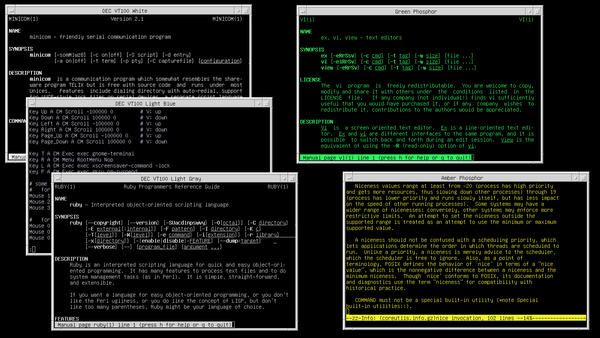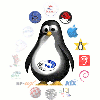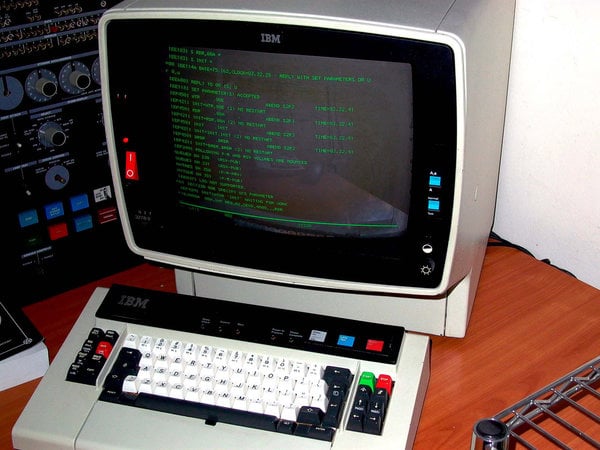Years ago, I read that the green screen phosphor terminals were actually better on peoples' eyes than modern PCs, due to the color of green causing less eye strain. That perked my interest, and I began being more interested in issues related to terminal colors and eye strain, and also figuring out color schemes emulating classic terminals. What I have here are a few settings that I've developed through basic experimentation that are generally very close to original terminal colors.
I'll explain each one of these:
Of course, invocation is as simple as...
If you hate ANSI colors in your terminals (they are ugly and make everything unreadable!), then you can mostly turn them off with a few lines of shell:
For anyone who thinks it's pointless or silly, if you use a computer often, you should pay attention to readability and eye strain. I've found that the green setting is very comfortable and easier on my eyes than other schemes. As for the colors themselves, they are closer to the "real deal" than the presets that come with terminal emulators like Gnome Terminal or Konsole. Those programs have very naive presets that don't actually match the historical colors. For example, gray-on-black does not match the light gray color of a classic terminal. Similarly, green-on-black is often simply any old green, without any thought or effort put into whether this green-on-black scheme even looks similar to an old terminal that it is presumably trying to emulate.
Code:
DEC VT100 light gray: #dddddd
DEC VT100 light blue: #99ddff
DEC VT100 white: #ffffff
Green phosphor terminal: #33ff66
Amber phosphor terminal: #ffff33
DEC VT100 light blue: #99ddff
DEC VT100 white: #ffffff
Green phosphor terminal: #33ff66
Amber phosphor terminal: #ffff33
I'll explain each one of these:
- DEC VT100 light gray: This is a basic light gray color that is closer to the actual light gray used by terminals, than the gray-on-black settings for many terminal emulators.
- DEC VT100 light blue: In many pictures and videos, the VT100 screens actually show a light blue tint that is very common. This is light gray with that blue tint.
- DEC VT100 white: Due to backlighting, VT100 characters could look almost white. Since that's the case, a basic white may be preferable in some cases.
- Green phosphor terminal: This is very easy on the eyes and close to the old green screens. This is the setting that I use every day.
- Amber phosphor terminal: This is the amber variant, not quite as easy on the eyes, but some people may prefer this style.
Of course, invocation is as simple as...
Code:
uxterm -bg black -fg '#33ff66' &
If you hate ANSI colors in your terminals (they are ugly and make everything unreadable!), then you can mostly turn them off with a few lines of shell:
Code:
TERM=vt220 && export TERM
alias ls 2>/dev/null && unalias ls
alias ls 2>/dev/null && unalias ls
For anyone who thinks it's pointless or silly, if you use a computer often, you should pay attention to readability and eye strain. I've found that the green setting is very comfortable and easier on my eyes than other schemes. As for the colors themselves, they are closer to the "real deal" than the presets that come with terminal emulators like Gnome Terminal or Konsole. Those programs have very naive presets that don't actually match the historical colors. For example, gray-on-black does not match the light gray color of a classic terminal. Similarly, green-on-black is often simply any old green, without any thought or effort put into whether this green-on-black scheme even looks similar to an old terminal that it is presumably trying to emulate.
Attachment:
_________________
Debian GNU/Linux on a ThinkPad, running a simple setup with Fvwm.














 -
-




 ...
...

 -
-






